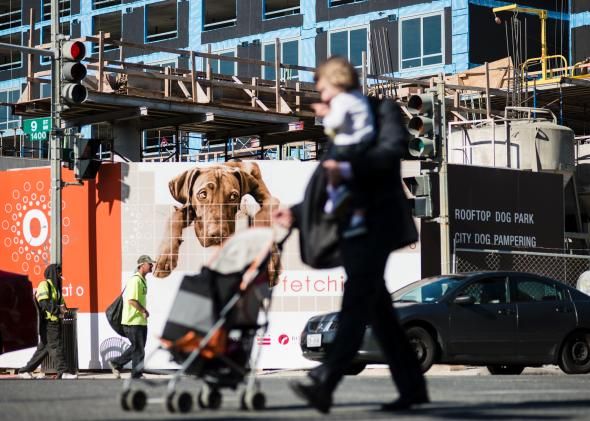
NYC Shelters Shut Down | No Single-Family Homes Fixed Since Sandy | Affordable Housing & de Blasio

(credit: Brendan Smialowski/AFP/Getty Images)
- New York is removing over 400 children from 2 homeless shelters. In the face of New York’s mounting homeless crisis, Mayor Bill de Blasio will announce on Friday that his administration is removing hundreds of children from two city-owned homeless shelters that inspectors have repeatedly cited for deplorable conditions over the last decade, officials said. The city has begun transferring over 400 children and their families out of the Auburn Family Residence in Fort Greene, Brooklyn, and from the Catherine Street shelter in Lower Manhattan, while vowing to improve services for the swelling population of 22,000 homeless children, Mr. de Blasio and other officials said in interviews this week.
- No single-family homes fixed with Build It Back funds since Sandy. Nearly a year and a half after Hurricane Sandy decimated large swaths of the city’s waterfront, not a single one-family home has been rebuilt or repaired with the nearly $700 million earmarked for recovery. Build It Back, created to help storm victims who were displaced, had nearly 20,000 single-family home applicants for relief funds. Just 171 of those have been awarded money out of the $306 million pot as of Feb. 20.
- Affordable housing: poised for de Blasio boost. It’s been a long time since affordable housing development was seen as the ugly duckling of the real estate world in New York City. In fact, its status rose under former Mayor Michael Bloomberg’s ambitious plan to develop and preserve 165,000 affordable units. Now the sector is poised to get another boost as the city’s new mayor, Bill de Blasio, starts implementing his agenda, which hinges on producing 200,000 affordable units.
- How to fix the housing component of CPI. For many purposes, including monetary policy, the federal government needs a statistical series to calculate the level of inflation in the economy. Because food and energy prices, though important to consumers, are highly unstable and deeply driven by nonmonetary factors (weather, political upheaval), it’s conventional to strip those out when assessing short-term monetary policy. But when you strip out food and energy prices, then a very large share of the remaining ‘core’ CPI is the price index for housing. And calculating the price index for housing is conceptually complicated because only a nonrandom minority of people rent, so you can’t really just go around and tally up rents.
- New Yorkers affected by hurricane rally for relief. A coalition of people affected by Hurricane Sandy asked Mayor Bill de Blasio today to deliver on his campaign promise to rebuild their neighborhoods. The Alliance for a Just Rebuilding released a report Tuesday morning showing that most homeowners hit by the storm have yet to see any of the millions of dollars they need.
- Argument over a brownstone neighborhood. Most people would agree that the brownstones and small apartment buildings nestled in the southwest corner of Bedford-Stuyvesant, Brooklyn, are for the most part drop-dead gorgeous. The 800 largely intact residential buildings, representing Italianate, Queen Anne, Romanesque Revival and Renaissance Revival styles, are executed in rich rusts, browns and terra cottas, and adorned with gracious bowed windows, generously proportioned stoops and adorable little turrets. The result, in the opinion of the New York City Landmarks Preservation Commission, is ‘an extraordinary well-preserved late-19th-century streetscape.
- The dangerous zone between a halfway house and freedom. There are at least 300 three-quarter houses in New York City, according to an October 2013 report by John Jay College, concentrated in low-income neighborhoods in central Brooklyn and housing an estimated 10,000 people. Three-quarter house residents are generally either homeless or just out of prison, residential substance abuse rehab or the hospital, according to the report.
- Blogger keeps focus on Brooklyn architecture, but now mostly from Upstate. he old industrial cities along the Hudson River in upstate New York have become magnets in recent years for creative former Brooklynites seeking cheaper, larger spaces in which to work and live. Among them is Suzanne Spellen, a lay historian who writes eight times a week about Brooklyn architecture but who found she could no longer afford to live in the borough.
- Wall Street landlords are buying bad loans. Wall Street-backed landlords are showing a greater appetite for bad mortgages as a source for cheap property as the supply of foreclosed homes declines while housing prices continue to climb. The companies have dominated U.S. foreclosure auctions in the last two years by buying as many as 200,000 single-family homes. Now American Homes 4 Rent, the second-biggest single-family landlord, Barry Sternlicht’s Starwood Waypoint Residential Trust and Altisource Residential Corp. are leading acquisitions of non-performing loans, or NPLs, to expand their holdings of rental properties.
- Winter likely to chill housing numbers. Pending-home sales data, expected Friday, could be even worse. If they disappoint, it would mark the eighth consecutive month of declines. That would be particularly troubling because these are a leading indicator, based on contract signings, as opposed to existing-home sales, which are based on closed sales.


